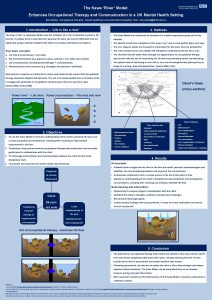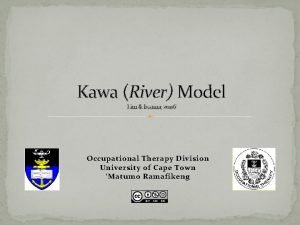The Kawa River Model Enhances Occupational Therapy and

- Slides: 1

The Kawa ‘River’ Model: Enhances Occupational Therapy and Communication in a UK Mental Health Setting Beki Dellow. Occupational Therapist. Dorset Health. Care University NHS Foundation Trust. beki. dellow@dhuft. nhs. uk 1. Introduction – ‘Life is like a river’ 3. Methods The Kawa (‘river’ in Japanese) Model uses the metaphor of a river to describe a person’s life • The Kawa Model was introduced to members of a creative expression group at the Day journey. It enables them to describe their personal life story and current difficulties that are significant using a familiar metaphor that others can easily understand relate to. Hospital. • The specific client drew metaphors of his Kawa ‘river’ and a cross-section (here and now). • The river diagram allows therapist to understand his life story, from his perspective. Four basic concepts: • The cross section of his river enables therapist to understand how his life is now. a. Life flow and well-being = river water • The channels that the water flows through are opportunities for occupational therapy intervention with the aim of maximising his life flow and promoting health and well-being. b. Environmental factors (e. g. physical, social, cultural) = river sides and riverbed • ‘An optimal state of well-being in one’s life or river can be metaphorically portrayed by an c. Life circumstances and problems/challenges = rocks/obstacles image of a strong, deep unimpeded flow’. (Iwama 2006, p 143) d. Personal factors and resources (e. g. strengths and barriers) = driftwood Each person’s experience of daily life is unique and should be the context that occupational therapy should be adapted and delivered. The aim is to enable people from all streams of life to engage and participate in occupations and processes that have personal value. Client’s Kawa (Iwama 2005; Iwama 2006) (cross-section) Kawa ‘river’ – Life story Kawa cross-section – The here and now a b c d Rocks/challenges River sides/river bed 2. Objectives Driftwood/personal factors - Self-awareness - Creative current occupational circumstances, clarifying their meaning to help facilitate - Capable improvement in life flow. - Fear of failure - Lack of confidence 1. To use the Kawa Model to increase understanding of the client’s personal life story and 2. To develop a truly person-centred occupational therapy intervention plan and formulate - Lost - Employed - Self-destructive - Family supportive (helpful but - Lack of qualifications can be too much) - No transport - How society is constructed - Financial difficulties - Why? - Poor concentration - Confusion - Lack of opportunities and interests - Poor mental health - Reduced motivation - Emptiness - Unable to find enjoyment in anything goals based in collaboration with the client. 3. To encourage and facilitate clear communication between the client and the multi- 4. Results disciplinary team. Assessment: 4. To promote and maximise the client’s health and well-being. • Allowed further insight into the client’s life flow and health, personal assets/strengths and liabilities, life circumstances/problems and impact of his environments. Diagnosis of chronic • All elements combined to form a unique picture of his life at that point in time. depression • Gained an understanding of the client’s metaphorical representations and occupational circumstances, clarifying their meaning and aiming to facilitate life flow. Goal planning and intervention: • Opportunity to analyse images in collaboration with the client. • Identified the client’s strengths, problems and personal challenges. Client • Set personal meaningful goals. 29 -year. Troubled by old male • Communicated findings with the psychiatrist, in order to review medication and assess Lived frequent independently in feelings of the past hopelessness Maintained full- and paranoia time employment level of suicide risk. Aim of occupational therapy - maximise life flow 5. Conclusion • The potential for occupational therapy intervention was limited in this case and the client’s river was almost completely obstructed with rocks, virtually blocking the flow. He was suicidal at the time of assessment and needed medical intervention. • Following assessment, the aim was to enable the client’s life to flow stronger and deeper despite residual obstacles. The Kawa Model can be used effectively as an outcome measure during and post intervention. • More research is needed on the effectiveness of the Kawa Model in practice, particularly in a Western context. References: Iwama MK (2006) The Kawa Model: Culturally Relevant Occupational Therapy Philadelphia: Churchill Livingstone Elsevier Iwama MK (2005) The Kawa River Model: Nature, life flow and the power of culturally relevant occupational therapy. In: Kronenberg F, Algado SA, Pollard N (Eds) Occupational Therapy Without Borders – Learning from the Spirit of Survivors Edinburgh: Churchill Livingstone Acknowledgements: Beki Dellow would like to acknowledge Dr. Michael K. Iwama Ph. D OT(C), Chair & Professor, Department of Occupational Therapy, Georgia Regents University for his inspiration, continuous support and encouragement and for allowing me to share his work. Further thanks to Kee Hean Lim, Lecturer in Occupational Therapy, Brunel University; Jou yin Teoh, Occupational Therapist/Director, Burn Bariatrics, Kuala Lumpar, Malaysia and David Nixon for their professional support and friendship.

